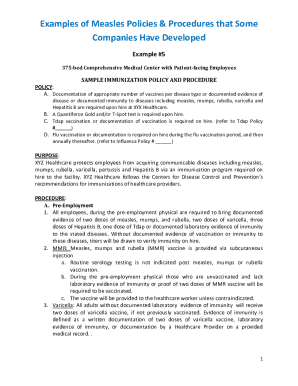Addressing The Persistence Of Measles: Strategies For Elimination

Table of Contents
Understanding Measles Persistence: Factors Contributing to Continued Outbreaks
The persistence of measles outbreaks, even in highly vaccinated populations, is a complex issue stemming from several interconnected factors. Understanding these factors is crucial for developing effective elimination strategies.
Vaccine Hesitancy and Misinformation
The rise of anti-vaccine movements and the proliferation of misinformation through social media platforms pose significant obstacles to achieving high vaccination coverage rates. False claims linking vaccines to autism or other health problems have fueled vaccine hesitancy, leading to decreased immunization rates and increased susceptibility to outbreaks.
- Examples of Misinformation: False claims about vaccine ingredients, fabricated links to autism, and exaggerated accounts of adverse effects.
- Impact of Social Media: The rapid spread of misinformation through social media platforms, often bypassing fact-checking and critical analysis.
- Effectiveness of Public Health Communication Campaigns: While public health campaigns aiming to correct misinformation are vital, their effectiveness varies, highlighting the need for innovative and targeted communication strategies.
Statistics show a strong correlation between vaccine hesitancy rates and measles outbreaks. In areas with low vaccine uptake, even a small decrease in herd immunity can trigger widespread outbreaks.
Challenges in Reaching Remote and Underserved Populations
Geographical barriers, poverty, and inadequate healthcare infrastructure create significant hurdles in delivering vaccines to marginalized communities. These populations often lack access to healthcare services, making them particularly vulnerable to measles outbreaks.
- Examples of Successful Outreach Programs: Mobile vaccination clinics, community health worker initiatives, and partnerships with local leaders to build trust and improve access.
- Innovative Vaccine Delivery Methods: Utilizing drones or other technologies to transport vaccines to remote areas, and leveraging existing community networks for distribution.
- Importance of Community Engagement: Engaging community leaders and influencers to promote vaccine uptake and address concerns.
Vaccination rates in these underserved populations are consistently lower than in more affluent areas, resulting in higher rates of infection and mortality from measles.
The Role of Surveillance and Outbreak Response
Effective surveillance systems are paramount in rapidly identifying and containing measles outbreaks. Prompt detection and rapid response are essential to prevent widespread transmission.
- Examples of Successful Surveillance Programs: Robust data collection systems, real-time monitoring of measles cases, and effective contact tracing protocols.
- Importance of Rapid Case Detection and Contact Tracing: Identifying cases early and tracing their contacts allows for swift intervention and prevents further spread.
- Challenges in Data Collection and Reporting: Inconsistent data reporting, lack of resources, and difficulties in accessing remote areas can hinder effective surveillance.
Effective Strategies for Measles Elimination: A Multi-pronged Approach
Eliminating measles requires a comprehensive, multi-pronged strategy that addresses the various factors contributing to its persistence.
Strengthening Vaccination Programs
High vaccination coverage rates are fundamental to measles elimination. This requires strengthening routine immunization schedules, implementing catch-up campaigns for unvaccinated children, and ensuring equitable access to vaccines for all.
- Strategies for Improving Vaccine Access and Uptake: Simplifying vaccine delivery systems, increasing vaccine availability, and implementing financial incentives or subsidies.
- The Role of Healthcare Workers and Community Health Workers: Training healthcare workers and community health workers to effectively administer vaccines and address vaccine hesitancy.
- Benefits of Integrating Measles Vaccination with Other Childhood Immunizations: Combining measles vaccination with other routine childhood immunizations improves efficiency and increases overall vaccination coverage.
Targeted Interventions for High-Risk Populations
Vulnerable groups, including refugees, migrants, and marginalized communities, require tailored strategies to ensure they receive adequate vaccination services. These strategies must be culturally sensitive and address the unique challenges faced by these populations.
- Examples of Successful Targeted Interventions: Outreach programs specifically designed for refugees and migrants, community-based vaccination drives, and partnerships with local organizations.
- Importance of Culturally Sensitive Communication: Tailoring communication strategies to resonate with the cultural values and beliefs of different communities.
- The Role of Community Leaders in Promoting Vaccination: Engaging community leaders and religious figures to promote vaccine uptake and build trust.
Improving Global Collaboration and Resource Allocation
International cooperation and sufficient funding are essential for achieving global measles elimination. This requires collaboration among governments, international organizations, and non-governmental organizations.
- Roles of International Organizations like WHO and UNICEF: Providing technical assistance, financial support, and coordinating global efforts towards measles eradication.
- Examples of Successful Global Collaborations: The Global Measles & Rubella Initiative (GMR) and other successful partnerships that have contributed to significant progress in measles control.
- Importance of Sustainable Funding Mechanisms: Securing long-term funding to support sustainable measles elimination programs.
Achieving Measles Elimination: A Collective Responsibility
Measles persistence is a complex issue fueled by vaccine hesitancy, inequitable access to healthcare, and inadequate surveillance systems. Effective measles eradication hinges on a multi-pronged approach incorporating strengthened vaccination programs, targeted interventions for high-risk populations, and enhanced global collaboration. The urgency of addressing measles outbreaks globally cannot be overstated. We must act now to prevent needless suffering and loss of life. Support measles elimination initiatives through vaccination, advocacy, or donations to organizations like WHO and UNICEF. Let us work collectively towards eliminating measles and building a healthier future for generations to come. Together, we can achieve global measles elimination and create a world free of this preventable disease.

Featured Posts
-
 The End Of An Era Deborra Lee Furnesss Perspective On Her Divorce From Hugh Jackman
May 30, 2025
The End Of An Era Deborra Lee Furnesss Perspective On Her Divorce From Hugh Jackman
May 30, 2025 -
 Border Patrol Rescues Two Women In Otay Mountains
May 30, 2025
Border Patrol Rescues Two Women In Otay Mountains
May 30, 2025 -
 Heatwave Deaths In England 311 Fatalities Highlight Urgent Need For Action
May 30, 2025
Heatwave Deaths In England 311 Fatalities Highlight Urgent Need For Action
May 30, 2025 -
 Pimbletts Surprise Prediction For Jones Vs Aspinall Ufc Heavyweight Title Clash
May 30, 2025
Pimbletts Surprise Prediction For Jones Vs Aspinall Ufc Heavyweight Title Clash
May 30, 2025 -
 Foreign Office Issues Urgent Greece Travel Warning For British Citizens
May 30, 2025
Foreign Office Issues Urgent Greece Travel Warning For British Citizens
May 30, 2025
Latest Posts
-
 Controversy Surrounds New Beatles Cast Understanding The White Boy Of The Month Criticism
May 31, 2025
Controversy Surrounds New Beatles Cast Understanding The White Boy Of The Month Criticism
May 31, 2025 -
 Beatles Casting Announcement Sparks Debate Examining The White Boy Of The Month Reaction
May 31, 2025
Beatles Casting Announcement Sparks Debate Examining The White Boy Of The Month Reaction
May 31, 2025 -
 The Beatles Cast Revealed A Look At The White Boy Of The Month Controversy
May 31, 2025
The Beatles Cast Revealed A Look At The White Boy Of The Month Controversy
May 31, 2025 -
 Podrobnosti Za Kontuziyata Na Grigor Dimitrov
May 31, 2025
Podrobnosti Za Kontuziyata Na Grigor Dimitrov
May 31, 2025 -
 Vzstanovyavane Na Grigor Dimitrov Sled Kontuziya
May 31, 2025
Vzstanovyavane Na Grigor Dimitrov Sled Kontuziya
May 31, 2025
